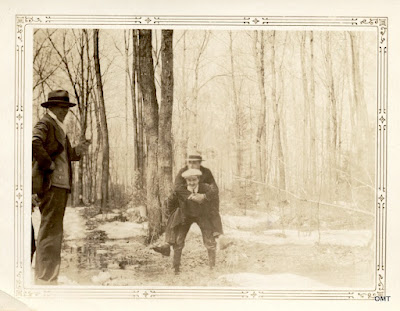Decorative borders
around 1930s snapshots
“Art is limitation. The essence of every
picture is the frame.”
G. K. Chesterton
During the 1930s it was fashionable for labs to print
snapshots within decorative borders. We can be more specific about this. The
earliest example in the collection comes from 1930 and people appear to have
lost interest in the idea about 1936. More than that, it seems particular to
North America. I haven’t seen examples from anywhere outside the US or Canada.
These things happen. In the mid 1970s the colour print with the satin finish
and rounded corners was the in thing, but that had the effect of making every
print look drab and uninteresting –similar to what happened around the same
time to anyone who wore a safari suit. These decorative borders on the other
hand could enhance a photo. With some of these images the borders belong to the
extent it is hard to imagine the photo without it, let alone improved by its
absence.
Part of that has to do with the way the border encloses the
image; everything happening off camera is shut out. I think this is the point
that Chesterton was making in the quote above. The frame contains the work so
the world beyond it ceases to exist. The borders in these snapshots do that but
at the same time they don’t intrude on the image.
As a topic of research in the history of photography you feel
that certainly these borders deserve attention, though preferably from someone
else. Where would you start? There are dozens and possibly hundreds of designs.
Some are distinctly Art Deco, mirroring the age, while others are more
traditional but is that important? Did labs carry several templates and ask the
customers which they preferred? Does that matter? It is intriguing how an idea
catches on then suddenly vanishes, suggesting this one wasn’t that popular to
begin with. Alternatively, the major companies like Kodak decided it wasn’t
worth the time or expense and shelved it.
What we like isn’t just the visual effect but the way these
borders place photographs in a particular time. This one of four men outside a
Quebec petrol station can only belong to the 1930s (Note the Marvelube sign on
the pole the man on the left is leaning against.) 1930s Men in overcoats and
hats will always look shifty.
Another photo from Canada (as I think most of these are). I
particularly like the way you need a moment to realize what the man is doing.
You’ll also notice the actual print doesn’t fit square within the frame created
by the border. This makes me think the designs might have been pre-exposed on
the paper before the lab printed it. The alternative would have been a template
on clear gel that was placed over the print.

The border seems especially suited to this beautifully
hand-coloured snapshot. It is also one of the most intricate. It looks like a
typically romantic scene but zoom in and there is something unsettling about
her stare.
One of those images that grows stranger every time you look
at it. Obviously, some parents were prepared to buy detailed and expensive
cubby houses for the kids, but these children’s poses and the boy being dressed
in a suit and tie makes the scene just a little disturbing.
As the very precise information on this one tells us, this
was taken on Saturday afternoon, July 21st, 1934, at Orchard Beach
in Maine. The women are E Taylor and Z Baxter.
And this one was taken three weeks earlier (July 1) at the
same beach. The women are not identified but note both photos have the same
decorative border. Presumably they were taken with the same roll of film though
it may have been that the lab used that design in preference to others.
This is the earliest, dated 1930, but while we describe these
as belonging to a particular age, this man’s pose and general demeanour look to
be a generation ahead of his time. Maybe there is a story about Canadian folk
music we haven’t heard yet.
Decorative borders similar to these were used on some large
format studio portraits in the 1910s and 20s but it was only when the idea was
taken up for snapshots that it really transformed images. A really good
snapshot is about something everyday that most likely has a simple explanation
but it transcends that. The obvious is dissatisfactory. We are convinced that
more than meets the eye is going on.
 |
| FRAMED |










No comments:
Post a Comment
Add comments here